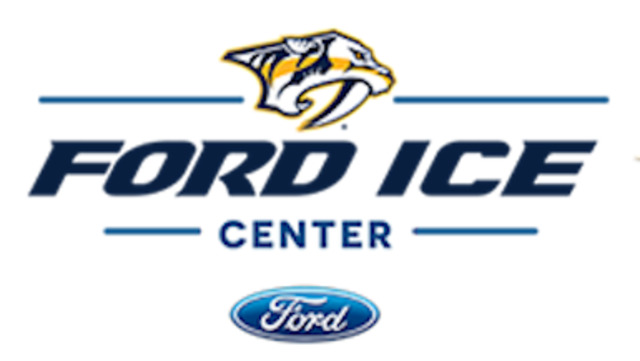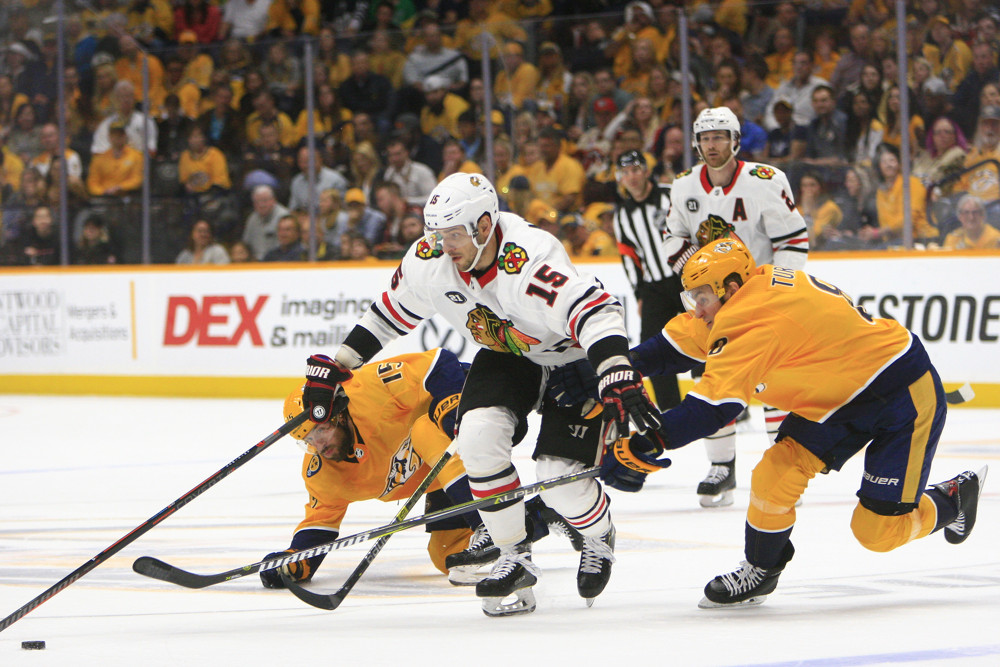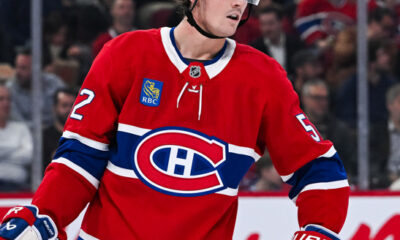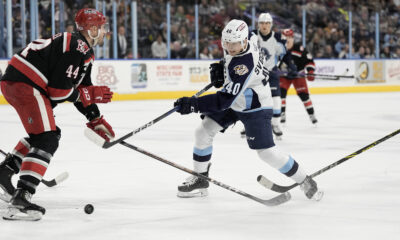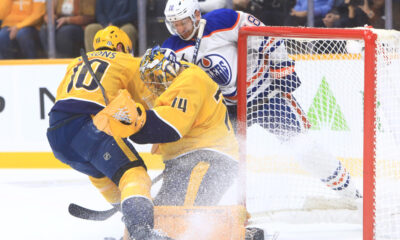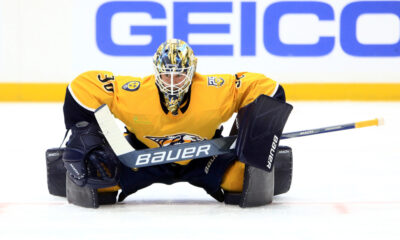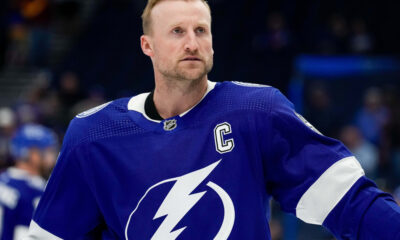
There’s not an easy way to begin this narrative considering Turris and Smith are legitimate second line threats who possess both pros and cons as individual players. Initially, the thought of moving Mikael Granlund to the third line crossed my mind, but that would serve no purpose than prohibiting Granlund’s potential. I like to think of Granlund as what Nashville wanted Kevin Fiala to be, so he’s most likely staying put. Both Turris and Smith have produced on the second line together, but the acquisition of Matt Duchene will inevitably alienate one of them. With two weeks remaining until hockey in Smashville is back, let’s see how each player would look with Granlund and Duchene (the locked-in second liners in my opinion).
The Playmaker

Forget the latter half of Turris’ 2018-2019 campaign- how did he play before he was injured in comparison to the rest of the team? Obviously, the JOFA line was propelling Nashville into prominence and the issues resided in secondary scoring, physicality, and the power play. Who was NOT the problem, you may ask? It was Kyle Turris who seemed part of the solution.
Through the first sixteen games of the season, here’s how production looked within the top six.
Arvidsson: 8 goals, 5 assists
Johansen: 3 goals, 14 assists
Forsberg: 10 goals, 5 assists
Fiala: 1 goal, 6 assists
Turris: 3 goals, 10 assists
Smith: 4 goals, 2 assists
That’s right, Turris haters. He was good when he was not hurt. It’s real easy to label him as the problem after he’s not playing full caliber after he broke the same ankle twice and rushed his recovery.

Putting this into a more simplified perspective, the first line produced 21 goals and 24 assists together, while the second line only managed 8 goals and 18 assists. Cough that up to whatever you may, but the difference between the two lines is not marginal. Arvidsson and Forsberg were miles better than Fiala and Smith, but Turris was keeping pace with Johansen (as that should be)- Turris simply did not have the kind of scoring support needed for a playmaking center.
Through the sixteen games, his average scoring chances for percentages rounded out to 54.54%, his average high danger chances for percentages rounded out to 53.23%, and averaged almost 3 high danger chances per game while he was on the ice. Turris was fourth on the team in points, pushing play, and generating chances before Arvidsson sustained an injury and everything went to hell. I consider Arvidsson’s long term injury the beginning of the end for last year’s season- once that happened, the lines were shuffled and chaos ensued. Treading water should never be a genuine game plan, but once three of the top six were out, it was all but bleak.
If I were to describe Turris while he was healthy, it would be subtle. He was a point getter on a failing line, and unfortunately, that went unnoticed.

Admittedly, Turris was subpar down the stretch. He was benched, some comments from him alluded to some potential ‘creative differences’ in his playing style and Laviolette’s system, and overall he did not play like Ottawa Senator Kyle Turris. However, in the grand scheme of things, when he scored his seven goals, Turris was not assisted by Mikael Granlund, Craig Smith, or Kevin Fiala once. Of his sixteen assists, only three of them were secondary. That should send a strong message- when he’s on, he is heavily involved in scoring.
He tied second on the team with power play goals with Craig Smith, trailing only Filip Forsberg. Just an interesting thought.
PROS
- Turris is forced to focus on his wrist shot
- Duchene is the better center out of all three of them in terms of faceoff percentages
- Granlund and Turris score more goals
- Low risk, high reward
- 20 goal scorer Craig Smith on the third line
CONS
- Two playmakers, one shooter
- Granlund’s shooting percentage is remarkably low, so is Turris’s- not as many shots, not as many goals (by default)
The Shooter
It’s hard to justify why Smith would not be on the second line- third on the team in goals (21), seventh in total points (38), third on the team in total shots on goal (205), and tied second on the team with power play goals (4). Basic statistics imply that is where he belongs. The benefit of playing with Matt Duchene would not DRAMATICALLY improve his play, but Duchene’s shooting percentage with both Columbus and Ottawa was a solid 15.5% accompanied by 172 shots on goal. Theoretically, two high volume shooters and a solid playmaker would boost production. That being said, that’s not always the case. The best case scenario with Smith on the second line would be a one-two punch with Nashville’s second line consisting of two assist machines and four volume shooters. Worst case scenario, the Predators would go back to the drawing board (Calle Jarnkrok on the second line sounds like the solution, right?) (*cricket noises*)
One thing I like about Smith is his reliability- we know exactly what we are going to get with him. 20 goals and 200 shots? There’s no shame in taking pride with that.
See more on what I had to say about Craig Smith here.
PROS
- SO MANY SHOTS ON GOAL
- Granlund becomes primary playmaker, only benefits Duchene and Smith more
- Kyle Turris centers third line, gives third line legitimacy
CONS
- Granlund’s ability is overshadowed and underappreciated
- Prohibits Duchene’s full potential
- Lowers Turris trade value significantly (in case Poile wanted to deal him away)
- Leaves the bottom six in uncertainty
Projected Lineup
In my opinion, Kyle Turris should be on the second line. His play with Team Canada is proof enough. I’d say Nashville’s opening night could look something like this.
Arvidsson-Johansen-Forsberg
Turris-Duchene-Granlund
Smith-Sissons-Jarnkrok
Grimaldi-Bonino-Watson
This would give the Predators the most balance in the lineup. Smith, Sissons, and Jarnkrok found some unknown chemistry towards the end of the season, and adding a volume shooter to a defensive-oriented line would rectify a lack of scoring in the bottom six. Rocco Grimaldi skating with Nick Bonino and Austin Watson severely hurts his scoring potential, but he’s still unproven. If he can score with them, he should be able to score with the third line.
Even as an experiment, displacing a member of the JOFA line for Duchene runs a serious risk. The problem I most see in this lineup lies in Johansen, Duchene and Granlund. All three of them are first line centers (based off point production with their former and current respective teams alone). Another high scoring winger would be nice, but I suppose it’s a good thing when the lineup is loaded enough that first line centers become second line wingers.
All in all, this is an intense year for many players. Granlund and Smith’s contracts are up, Turris does not have much trade value right now, and Matt Duchene is the Predators’ new poster boy. A lot of skilled players now have something to prove to not only the team and the fans, but to themselves as well.
